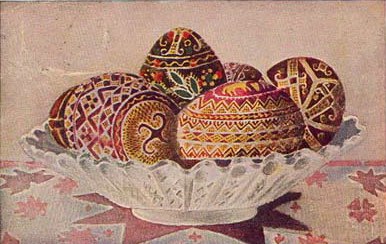Traditions:
Talismanic Uses
Traditions:
Talismanic Uses

Talismanic Uses
While most of the pysanky that were made in a given year were given away to other people, some were saved and used for talismanic purposes. A pysanka held very strong magic, and was used for protection of the family and the home throughout the year.
❖ Several were saved to keep in the home for protection from fire and storms.
❖ Two or three were placed in the trough where animals ate, so they would have many young.
❖ At least one egg was placed beneath the bee hive to insure a good harvest of honey.
❖ One was saved for each grazing animal to be taken out to the fields with the herders in the spring.
Home: A bowl full of pysanky was invariably kept in every home. It served not only as a colorful display, but also as protection from lightning and fire. Particularly powerful were pysanky with a spiral design–evil spirits would be attracted to the spiral, and then trapped inside it, unable to escape
Some of the eggs were hung instead. A bird’s head would be made of wax or bread dough, and wings and tail feathers of folded paper attached. These “doves” were suspended before icons in commemoration of the birth of Christ, when a dove came down from heaven and soared over the child Jesus. Or the pysanky might be strung on a string with a tassel, or encased in a straw bird. In either case, the pysanka was a powerful “oberih” (оберіг, charm) used to keep the home and family safe.
Pysanky were particularly protective from fire, an important consideration in times of open hearths and wooden structures. If a fire did break out, a blessed egg would be thrown across it to help put it out.
Pysanky were strong magic, and, if allowed to fall into the wrong hands, such as those of a witch, could prove dangerous. She could uses pieces of the egg shell to collect the morning dew and use it to dry up a milk cow, or she could use sharpened bits of shell to poke a person and make them sicken.
Broken pysanky, for these reasons, had to be carefully disposed of, either ground up and fed to the animals, or thrown into running water.
Pysanky, and the cloths used to help make them, could be burned, and the smoke used to fumigate disease (both from people and animals) and cure to skin infections. Blessed eggs were useful for treating ague, toothaches, night blindness and various other maladies
Animals: A family’s animals were also protected and their fertility promoted by pysanky. The sign of a cross was made over each animal with a blessed pysanka on Easter to bless it, and several pysanky were hung by a string in the stable to provide protection throughout the year. Pysanky might be placed in beehives and feeding troughs as well.
The shell of a pysanka, ground up, was fed to the chickens so that they might lay many eggs. A ground up blessed egg, either pysanka or krashanka, might be crumbled into bran and fed to the livestock.
As with people, animals could be cured of diseases by fumigating them with the smoke from a burned blessed eggshell (usually krashanka).
Back to Traditions home page
Back to MAIN Pysanka home page.
Back to Pysanka Index.
